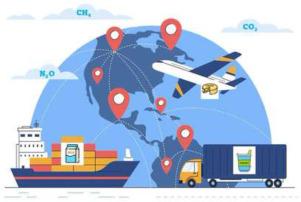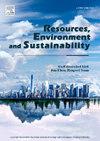Implications of a consumption-based accounting of greenhouse gas emissions from global dairy cattle systems
IF 7.8
Q1 ENVIRONMENTAL SCIENCES
引用次数: 0
Abstract
Greenhouse gas (GHG) emissions from dairy systems at the national level are typically estimated at the point of production, following guidelines for national reporting. However, exploring the emissions allocated to the point of consumption also provides key insights into reducing emissions across all stages (inputs, production, trade, and consumption). In this study, the GHG emissions associated with global dairy cattle products were estimated using a consumption-based accounting approach. The analysis was based on data from 2015, covering 254 territories and considering 21 dairy cattle commodities. Our findings reveal that international trade in dairy products is dominated by a few countries, with the top 20 net importing/exporting countries accounting for about 70% of global emissions embodied in trade. Although, at the global level, GHG emissions embodied in the international trade of dairy cattle products represented a relatively small share of the total (133 Mt CO2 eq, 9%), they were significant at the country level, particularly for countries heavily involved in trade. In some cases, imports accounted for more than 50% of consumption-related emissions. Trade among European Union countries was relevant representing 32% of the global GHG emission linked with the international trade of dairy products. By adopting a system-wide approach, this study aims to provide novel and critical information to reduce GHG emissions from the global dairy sector, contributing to initiatives such as Pathways to Dairy Net Zero. The results are discussed in the context of the importance of dairy products for global food security. The consumption-based analysis presented represents a different and original perspective in the computation of GHG emissions at the national level for a specific and relevant food item. This approach, guiding policymakers in identifying key impact areas across all stages of the supply chain, can foster the transition to low-carbon dairy products, and support circular economy practices.

以消费为基础的全球奶牛系统温室气体排放核算的含义
国家一级乳制品系统的温室气体(GHG)排放量通常在生产点进行估算,并遵循国家报告准则。然而,探索分配到消费点的排放也为减少所有阶段(投入、生产、贸易和消费)的排放提供了关键见解。在本研究中,使用基于消费的核算方法估算了与全球奶牛产品相关的温室气体排放。该分析基于2015年的数据,涵盖254个地区,并考虑了21种奶牛商品。我们的研究结果表明,乳制品的国际贸易由少数几个国家主导,前20个净进口国/出口国占全球贸易隐含排放量的70%左右。虽然在全球层面上,奶牛产品国际贸易中体现的温室气体排放量占总量的比例相对较小(1.33亿吨二氧化碳当量,9%),但在国家层面上,特别是对那些大量参与贸易的国家来说,它们的排放量很大。在某些情况下,进口占消费相关排放量的50%以上。欧盟国家之间的贸易是相关的,占与乳制品国际贸易相关的全球温室气体排放量的32%。通过采用全系统的方法,本研究旨在为减少全球乳制品行业的温室气体排放提供新颖而关键的信息,为“乳品零排放之路”等倡议做出贡献。研究结果在乳制品对全球粮食安全的重要性的背景下进行了讨论。所提出的以消费为基础的分析代表了在国家一级计算特定和相关食品的温室气体排放量的不同和原始的视角。这种方法可以指导政策制定者确定供应链各个阶段的关键影响领域,促进向低碳乳制品的过渡,并支持循环经济实践。
本文章由计算机程序翻译,如有差异,请以英文原文为准。
求助全文
约1分钟内获得全文
求助全文
来源期刊

Resources Environment and Sustainability
Environmental Science-Environmental Science (miscellaneous)
CiteScore
15.10
自引率
0.00%
发文量
41
审稿时长
33 days
 求助内容:
求助内容: 应助结果提醒方式:
应助结果提醒方式:


